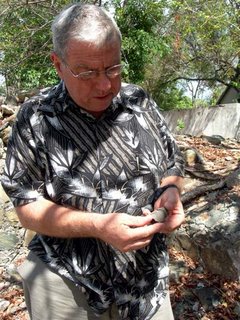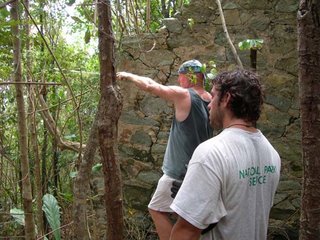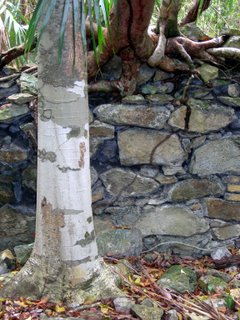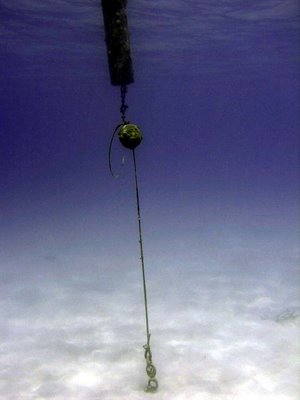
The first part of the week Mick was investigating the petroglyphs on St. Kitts for a brief vacation. Ken and Susanna visited Caneel with Chuck Pishko. Chuck had located an 18th century candelabra at the kitchen area of the historic mangers house. Since the artifact was in the open where it could be collected as a keepsake, he concealed it and marked where he had discovered it. We collected the GPS data and the artifact. Thank you Chuck. (photo: Chuck Pishko with candelabra at Caneel)
Much of this week was devoted to cataloging. However, the interns had a busy and exhausting day on Thursday. The government requires each park to document the existence of all archeological sites, most sites have to be visited, and their condition reassessed every five years. This year we must find seven sites that the park has never assessed. We visited three of the sites on Thursday:, Hope, Paquerau, and Bordeaux Plantations. Luckily, for us, we were able to enlist the help of Peter Burgess, a St. John resident and avid hiker who is familiar with the locations of all three plantations.
 Peter had been there several times and generously volunteered to take us to the plantations. Following an Old Danish road, he led us up and down Bordeaux Mountain to each plantation. At the plantations, we assessed the condition of each archeological site and buildings. We collected GPS points on the corners of each structure so we can put them accurately on our GIS map and enter them into our Archeological Sites Management Information System (ASMIS). We also took length and width measurements of the buildings. Susanna photographed the buildings with us working as further documentation in the event the park is audited. We accomplished a great deal thanks to Peter and his knowledge of the island.
Peter had been there several times and generously volunteered to take us to the plantations. Following an Old Danish road, he led us up and down Bordeaux Mountain to each plantation. At the plantations, we assessed the condition of each archeological site and buildings. We collected GPS points on the corners of each structure so we can put them accurately on our GIS map and enter them into our Archeological Sites Management Information System (ASMIS). We also took length and width measurements of the buildings. Susanna photographed the buildings with us working as further documentation in the event the park is audited. We accomplished a great deal thanks to Peter and his knowledge of the island. (photo: Peter and Mick at Hope Plantation; Threat of Vegetation to Ruins at Paqeurau)
(photo: Peter and Mick at Hope Plantation; Threat of Vegetation to Ruins at Paqeurau)On Friday, Ken and Susanna completed an underwater survey at Trunk Bay so the park can install two sand screws for a dingy tether (a place to tie your dingy offshore). The tether will allow a dingy a place to park when the shore swells are too high for a safe beach landing. This archeological survey work is an example of basic resource compliance. In other words making sure that when they build, install, repair, renovate, restore, stabilize, or demolish anything in the park we first make sure no cultural resource are going to be damaged and if so, then a new process of mitigation is followed. But that is another story as nothing was found Friday except abandoned masks and snorkels.


(Photo: Channel Marker Screw in Trunk Bay, Depth, 15ft; Coral in the vincinity of cultural resources, Trunk Bay, 25ft)




2 comments:
Beautiful pictures, Mick. What an interesting job - finding all those artifacts and having fun doing it. We are so proud of you.
Looking forward to seeing you in May. Athens
Good work Mick, looking forward to the PJ concert. Take care
Post a Comment